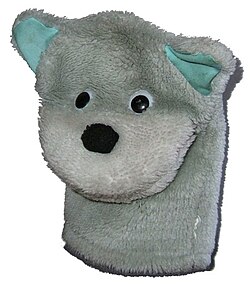AY Honors/Puppetry/Answer Key
A hand puppet (also called a glove puppet or glove doll) is a type of puppet that is primarily controlled by a hand that occupies the interior of the puppet. Larger varieties of hand puppets place the puppeteer's hand in just the puppet's head, controlling the mouth and head, and the puppet's body then hangs over most or all of the forearm of the puppeteer, and possibly extends further. Other parts of the puppet may be controlled by different means, e.g., by rods operated by the puppeteer's free hand, or strings or levers pulled from inside the head or body. A smaller variety, simple hand puppets often have no significant manipulable parts at all. Finger puppets are hand puppets made only to fit a finger.
Simple hand puppets
The simplest hand puppets are those with few or no moving parts. They can be stiff, made from e.g. a hard plastic, but are more often flexible, made from fabric, possibly with some stuffing and attached decorations for eyes, nose, and so on. The mouth may be a mere decoration that does not open and close, or the thumb may enter a separate pocket from the rest of the fabric and so simulate a mandible, allowing the puppet to talk.
Simple hand puppets are usually not much larger than the hand itself. A sock puppet is a particularly simple type of hand puppet made from a sock. A glove puppet is slightly more complex, with an internal division for fingers allowing independent manipulation of a character's arms.
Simple hand puppets, especially of popular licensed characters, are often distributed as children's toys or party favors.
Larger Hand Puppets

Larger and more complex hand puppets generally have, at minimum, a complete working hinged mouth, and usually arms as well. Special variants exist with additional manipulable parts: e.g., eyelids that open and close. Most hand puppets depict only the upper half of the character, from the waist up, with the stage covering the missing remainder, but variants also exist that have legs. The legs usually just dangle, but in special cases the legs may be controlled either from behind the stage using strings that dangle over the top of the stage and control the legs from above (like a marionette's, or by another puppeteer using rods from below, hidden by a lower and more forward part of the opera.
Moving more upmarket, things such as old favourites like sooty, where used to help educate children to make learning more fun. Children that way gain more pleasure form seeing the furry creatures acting and talking like humans.
Puppets are used at place like primary school to help educate as said above.
External links
- PuppetryLab - Advanced puppetry theory and practice tools
- Hand Puppets - A variety of links and information about building hand puppets.
- 101 Hand Puppets - A guide for puppeteers of all ages
- Puppetools - An Online Workshop for Educators Focused on Play Language

